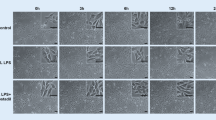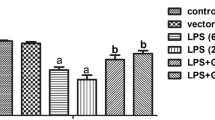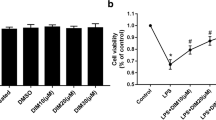Abstract
Luteolin, a plant flavonoid, has been shown to suppress inflammatory responses; however, the mechanism of luteolin on cardiac myocyte inflammation is still unknown. Because tumor necrosis factor-α (TNF-α), an inflammatory cytokine, is elevated in the failing heart and exerts multiple potentially harmful effects on cardiac myocytes, we therefore sought to examine the effects of luteolin on the expression of TNF-α in neonatal rat cardiac myocytes. In the present study, enzyme-linked immunosorbent assay (ELISA), real-time PCR, immunoblot, immunochemistry staining, and electrophoretic mobility shift assays (EMSA) were performed. ELISA assay showed that luteolin decreased lipopolysaccharide (LPS)-induced production of TNF-α in the medium. Real-time PCR assay confirmed that luteolin also inhibited LPS-induced increase in TNF-α mRNA in myocytes. Furthermore, immunoblot and immunochemistry staining assays represented that luteolin blocked LPS-induced IκB-β degradation and NF-κB p65 subunit nuclear translocation. In addition, EMSA demonstrated that luteolin reduced LPS-induced NF-κB DNA binding activity. Luteolin protects against LPS-induced TNF-α expression via inhibition of the NF-κB signaling pathway, suggesting that luteolin may be a potential therapeutic agent for the treatment of inflammation-related myocardial diseases.







Similar content being viewed by others
Abbreviations
- LPS:
-
Lipopolysaccharide
- TNF-α:
-
Tumor necrosis factor-α
- DMEM:
-
Dulbecco’s modified Eagle’s medium
- ELISA:
-
Enzyme-linked immunosorbent assay
- NF-κB:
-
Nuclear factor-κB
- PDTC:
-
Pyrrolidine dithiocarbamate
- EMSA:
-
Electrophoretic mobility shift assays
REFERENCES
Feldman, A.M., A. Combes, D. Wagner, T. Kadakomi, T. Kubota, Y.Y. Li, and C. McTiernan. 2000. The role of tumor necrosis factor in the pathophysiology of heart failure. Journal of the American College of Cardiology 35: 537–544.
Meldrum, D.R. 1998. Tumor necrosis factor in the heart. The American Journal of Physiology 274: R577–R595.
Hickson-Bick, D.L., C. Jones, and L.M. Buja. 2006. The response of neonatal rat ventricular myocytes to lipopolysaccharide-induced stress. Shock 25: 546–552.
Candelore, M.R., M.J. Wright, L.M. Tota, J. Milligan, G.J. Shei, J.D. Bergstrom, and S.M. Mandala. 2002. Phytosphingosine 1-phosphate: a high affinity ligand for the S1P(4)/Edg-6 receptor. Biochemical and Biophysical Research Communications 297: 600–606.
Valen, G., Z.Q. Yan, and G.K. Hansson. 2001. Nuclear factor kappa-B and the heart. Journal of the American College of Cardiology 38: 307–314.
Takeshita, A., H. Shinoda, Y. Nakabayashi, A. Takano, K. Matsumoto, M. Suetsugu, K. Miyazawa, S. Tanaka, H. Endo, S. Tanaka, Y. Ueyama, A. Hanzawa, Y. Suda, H. Kanegae, and T. Yasui. 2005. Sphingosine 1-phosphate acts as a signal molecule in ceramide signal transduction of TNF-alpha-induced activator protein-1 in osteoblastic cell line MC3T3-E1 cells. Journal of Oral Science 47: 43–51.
Jaffe, A.B., A. Hall, and A. Schmidt. 2005. Association of CNK1 with Rho guanine nucleotide exchange factors controls signaling specificity downstream of Rho. Current Biology 15: 405–412.
Jennings, G.R., M.R. Castresana, and W.H. Newman. 2004. Regulation of tumor necrosis factor-alpha production in the isolated rat heart stimulated by bacterial lipopolysaccharide or reactive oxygen. The American Surgeon 70: 797–800.
Shimoi, K., H. Okada, M. Furugori, T. Goda, S. Takase, M. Suzuki, Y. Hara, H. Yamamoto, and N. Kinae. 1998. Intestinal absorption of luteolin and luteolin 7-O-beta-glucoside in rats and humans. FEBS Letters 438: 220–224.
Xagorari, A., A. Papapetropoulos, A. Mauromatis, M. Economou, T. Fotsis, and C. Roussos. 2001. Luteolin inhibits an endotoxin-stimulated phosphorylation cascade and proinflammatory cytokine production in macrophages. The Journal of Pharmacology and Experimental Therapeutics 296: 181–187.
Kotanidou, A., A. Xagorari, E. Bagli, P. Kitsanta, T. Fotsis, A. Papapetropoulos, and C. Roussos. 2002. Luteolin reduces lipopolysaccharide-induced lethal toxicity and expression of proinflammatory molecules in mice. American Journal of Respiratory and Critical Care Medicine 165: 818–823.
Kim, S.H., K.J. Shin, D. Kim, Y.H. Kim, M.S. Han, T.G. Lee, E. Kim, S.H. Ryu, and P.G. Suh. 2003. Luteolin inhibits the nuclear factor-kappa B transcriptional activity in Rat-1 fibroblasts. Biochemical Pharmacology 66: 955–963.
Gutierrez-Venegas, G., P. Kawasaki-Cardenas, S.R. Arroyo-Cruz, and S. Maldonado-Frias. 2006. Luteolin inhibits lipopolysaccharide actions on human gingival fibroblasts. European Journal of Pharmacology 541: 95–105.
Chen, C.Y., W.H. Peng, K.D. Tsai, and S.L. Hsu. 2007. Luteolin suppresses inflammation-associated gene expression by blocking NF-kappaB and AP-1 activation pathway in mouse alveolar macrophages. Life Sciences 81: 1602–1614.
Wagner, D.R., A. Combes, C. McTiernan, V.J. Sanders, B. Lemster, and A.M. Feldman. 1998. Adenosine inhibits lipopolysaccharide-induced cardiac expression of tumor necrosis factor-alpha. Circulation Research 82: 47–56.
Fu, J.J., H. Gao, R.B. Pi, and P.Q. Liu. 2005. An optimized protocol for culture of cardiomyocyte from neonatal rat. Cytotechnology 49: 109–116.
Pfaffl, M.W. 2001. A new mathematical model for relative quantification in real-time RT-PCR. Nucleic Acids Research 29: e45.
Kim, H.K., B.S. Cheon, Y.H. Kim, S.Y. Kim, and H.P. Kim. 1999. Effects of naturally occurring flavonoids on nitric oxide production in the macrophage cell line RAW 264.7 and their structure-activity relationships. Biochemical Pharmacology 58: 759–765.
Jang, S., K.W. Kelley, and R.W. Johnson. 2008. Luteolin reduces IL-6 production in microglia by inhibiting JNK phosphorylation and activation of AP-1. Proceedings of the National Academy of Sciences of the United States of America 105: 7534–7539.
Verma, I.M., J.K. Stevenson, E.M. Schwarz, D. Van Antwerp, and S. Miyamoto. 1995. Rel/NF-kappa B/I kappa B family: intimate tales of association and dissociation. Genes & Development 9: 2723–2735.
Wright, G., I.S. Singh, J.D. Hasday, I.K. Farrance, G. Hall, A.S. Cross, and T.B. Rogers. 2002. Endotoxin stress-response in cardiomyocytes: NF-kappaB activation and tumor necrosis factor-alpha expression. American Journal of Physiology. Heart and Circulatory Physiology 282: H872–H879.
Swantek, J.L., L. Christerson, and M.H. Cobb. 1999. Lipopolysaccharide-induced tumor necrosis factor-alpha promoter activity is inhibitor of nuclear factor-kappaB kinase-dependent. The Journal of Biological Chemistry 274: 11667–11671.
Kim, J.S., and C. Jobin. 2005. The flavonoid luteolin prevents lipopolysaccharide-induced NF-kappaB signalling and gene expression by blocking IkappaB kinase activity in intestinal epithelial cells and bone marrow-derived dendritic cells. Immunology 115: 375–387.
Comalada, M., I. Ballester, E. Bailon, S. Sierra, J. Xaus, J. Galvez, F.S. de Medina, and A. Zarzuelo. 2006. Inhibition of proinflammatory markers in primary bone marrow-derived mouse macrophages by naturally occurring flavonoids: analysis of the structure-activity relationship. Biochemical Pharmacology 72: 1010–1021.
Torre-Amione, G., S. Kapadia, J. Lee, J.B. Durand, R.D. Bies, J.B. Young, and D.L. Mann. 1996. Tumor necrosis factor-alpha and tumor necrosis factor receptors in the failing human heart. Circulation 93: 704–711.
Haudek, S.B., E. Spencer, D.D. Bryant, D.J. White, D. Maass, J.W. Horton, Z.J. Chen, and B.P. Giroir. 2001. Overexpression of cardiac I-kappaBalpha prevents endotoxin-induced myocardial dysfunction. American Journal of Physiology. Heart and Circulatory Physiology 280: H962–H968.
Hall, G., J.D. Hasday, and T.B. Rogers. 2006. Regulating the regulator: NF-kappaB signaling in heart. Journal of Molecular and Cellular Cardiology 41: 580–591.
Soo, I., K.L. Madsen, Q. Tejpar, B.C. Sydora, R. Sherbaniuk, B. Cinque, L. Di Marzio, M.G. Cifone, C. Desimone, and R.N. Fedorak. 2008. VSL#3 probiotic upregulates intestinal mucosal alkaline sphingomyelinase and reduces inflammation. Canadian Journal of Gastroenterology 22: 237–242.
Tormakangas, L., P. Vuorela, E. Saario, M. Leinonen, P. Saikku, and H. Vuorela. 2005. In vivo treatment of acute Chlamydia pneumoniae infection with the flavonoids quercetin and luteolin and an alkyl gallate, octyl gallate, in a mouse model. Biochemical Pharmacology 70: 1222–1230.
Kang, O.H., J.G. Choi, J.H. Lee, and D.Y. Kwon. 2010. Luteolin isolated from the flowers of Lonicera japonica suppresses inflammatory mediator release by blocking NF-kappaB and MAPKs activation pathways in HMC-1 cells. Molecules 15: 385–398.
Li, X.Q., W. Cao, T. Li, A.G. Zeng, L.L. Hao, X.N. Zhang, and Q.B. Mei. 2009. Amlodipine inhibits TNF-alpha production and attenuates cardiac dysfunction induced by lipopolysaccharide involving PI3K/Akt pathway. International Immunopharmacology 9: 1032–1041.
Takano, H., T. Nagai, M. Asakawa, T. Toyozaki, T. Oka, I. Komuro, T. Saito, and Y. Masuda. 2000. Peroxisome proliferator-activated receptor activators inhibit lipopolysaccharide-induced tumor necrosis factor-alpha expression in neonatal rat cardiac myocytes. Circulation Research 87: 596–602.
ACKNOWLEDGMENTS
This study was based on a project supported by the Scientific Research Fund of Hunan Provincial Education Department (no: 09C048), China. We thank Dr. Tian Lan for the helpful suggestion and discussion during the study.
Conflicts of interest
The authors affirm that they have no conflicts of interest.
Author information
Authors and Affiliations
Corresponding author
ELECTRONIC SUPPLEMENTARY MATERIALS
Below is the link to the electronic supplementary material.
ESM 1
(GIF 389 kb)
Rights and permissions
About this article
Cite this article
Lv, L., Lv, L., Zhang, Y. et al. Luteolin Prevents LPS-Induced TNF-α Expression in Cardiac Myocytes Through Inhibiting NF-κB Signaling Pathway. Inflammation 34, 620–629 (2011). https://doi.org/10.1007/s10753-010-9271-7
Published:
Issue Date:
DOI: https://doi.org/10.1007/s10753-010-9271-7




